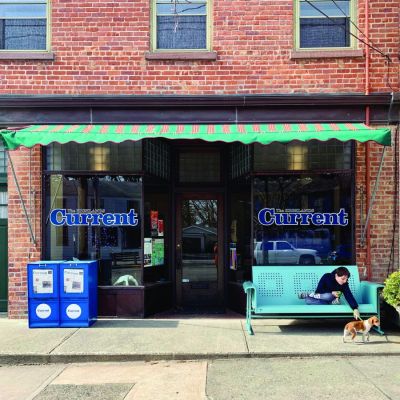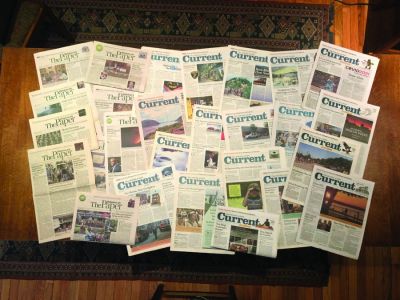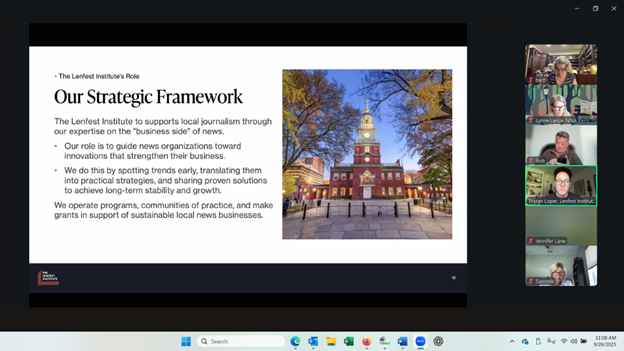Nonprofit Highlands Current still going strong after 10 years in circulation
Teri Saylor
Special to Publishers' Auxiliary
Sep 1, 2022




The Highlands Current was born in Cold Springs, New York, not long after Roger Ailes came to town.
The late Ailes, who counseled Republican presidents before creating the Fox News Channel, purchased The Putnam County News and Recorder and the Putnam County Courier in 2008. Both newspapers are well established and have been covering the county news for almost two centuries. As Ailes nudged the newspapers’ editorial pages to the right in a county that is nearly evenly split between Democrats and Republicans, the left-leaning residents sought other options.
“The progressive voters in town began meeting to discuss starting another newspaper,” said Highlands Current editor Chip Rowe. But they could not agree on the format and couldn’t get a newspaper off the ground.
On July 4, 2010, Gordan Stewart, a local businessman and former speechwriter for President Jimmy Carter, launched Phillipstown Dot Info, a news website covering Phillipstown and Beacon, two towns with a combined population of about 23,000 in the western part of Putnam County. He hired three editors and two reporters.
He funded the website out of his own pocket, then decided the media site needed a print companion, so he put up more money, hired a page designer and an ad sales executive, and started a print publication dubbed The Paper. The debut issue came out on June 1, 2012.
Last January, Rowe and his team rang in the New Year by celebrating the print edition’s 500th issue, under Rowe’s Editor’s Notebook headline “Looks Like We Made It.”
Before Stewart died in 2014, he converted his enterprise into a reader-funded, nonprofit news organization to keep it going with community support, Rowe said. In 2016, the newspaper’s board changed its name to The Highlands Current.
Today, The Highlands Current is still going strong, both in print and online, with a membership program and supporters who provide generous funding. The weekly, free-distribution newspaper has more than 900 members.
“Many members are sustainers who give $10 a month, which is the model we sought,” Rowe said. “Our goal by the end of the year is to have 1,000 members.”
While the newspaper is distributed free in outlets across the county, members receive their copies in the mail. The news organization also gives away tote bags and other premiums, including an opportunity to participate in an annual discussion with the editor and board members.
“We invite 10 or 20 of our members at a time to meetings, where we receive their feedback and answer questions, and we have some pretty candid conversations,” Rowe said. “What I find helpful is discussing where we could be doing a better job and talking about what might be missing from our coverage. We get stories out of that every time.”
COVID-19 put a damper on those meetings, but with pandemic precautions lifting, the newspaper is ramping those meetings back up.
A graduate from Northwestern University with both bachelor’s and master’s degrees in journalism, Rowe spent the early part of his career at newspapers in the Midwest before joining the editorial team at Playboy Magazine. After he was laid off, he became a professional genealogist and a freelance writer before going to work as editor of The Highlands Current in 2016.
In addition to Rowe, the newspaper employs two full–time editors and a stable of part–time editors, reporters, columnists and photographers. A part–time designer, advertising manager, illustrator and a cadre of freelance reporters round out the paper’s crew.
A Board of Directors and a Board of Advisers fill the traditional publisher’s role, and they bring to the table a variety of backgrounds and experiences.
While some nonprofit news organizations fill a niche role, like public service or investigative journalism, or cover a specific topic, like education, the environment or health care, The Highlands Current is a general interest newspaper, covering local government, schools, sports and routine day-to-day community matters.
The newspaper has won many awards, including NNA’s 2022 Community and Civic Service Award for its coverage of “Hunger in the Highlands.”
“Even though we're in a relatively wealthy area of New York, during the pandemic, our food pantries were being crushed,” Rowe said. “The community raised hundreds of thousands of dollars privately to help people who lost their jobs or were furloughed and weren't getting three meals a day.”
This year, The Highlands Current was the 2022 New York Press Association’s Newspaper of the Year and received the association’s Thomas G. Butson Award for Investigative In-Depth Reporting among papers with circulations of 4,000 to 12,000. The newspaper reports it has won 97 NYPA awards since 2013.
“I think we put out a great newspaper,” Rowe said.
Putnam County is located about 60 miles north of New York City in the Hudson River Valley. With a population of about 98,000, the county is home to several community newspapers, including the original weeklies, Putnam County News and Putnam Courier, which are still circulating. After Ailes died in 2017, his wife sold the newspapers to their editor, Douglas Cunningham.
“We have an interesting situation here, where we have a small community with multiple newspapers, whereas some towns and counties have none,” Rowe said. “I think it’s healthy to have an abundance of news coverage.”
The Highlands Current is a member of the Trust Project, an international consortium of news organizations promoting standards of transparency, accuracy, inclusion, and fairness, which give the public an opportunity to make informed news choices. The newspaper publishes its editorial standards on its website, along with a list of its members and donors.
The formula seems to be working, and Rowe maintains a fascination with his audience.
“A lot of people are intrigued with the idea that we are sort of producing two products — one in print and one online,” Rowe said. “I always wonder if we have separate audiences along with our separate platforms and what percentage of them read both.”
Even though printing is expensive and growing more difficult, Rowe and the board keep putting out the news in ink on paper because of its popularity. They print 4,000 copies each week and distribute them free through the mail to members and on racks, and they log just over 100 returns, Rowe said.
Despite this success, he sees plenty of room for growth and is constantly seeking ways to reach more people. The newspaper’s non-profit status seems to be of no concern to readers and members.
“We’re like any newspaper, striving to cover the community, get the stories right and do it consistently,” he said. “I believe that’s what converts people to readers, maybe not after reading one issue, but after reading 20 they may become our fans.”
Rowe describes The Highlands Current as a “lean machine,” with most of its costs in salaries and printing, just like other newspapers. As a nonprofit entity, the newspaper also has the added layer of fundraising expenses and record-keeping necessary to maintaining its nonprofit status, which Rowe sees as a positive.
“Our nonprofit status makes us more transparent, and our readers and customers can see where their money’s going,” he said. “Gordon founded our newspaper as a free community service, so people aren’t required to give us money to read it.”
Rowe views newspapers as critical utilities like electricity and water — necessary to providing a high standard of living in a community.
“During the pandemic, we saw newspaper reporters classified as essential workers,” he said. ”And I think the model of how to present a newspaper to a community is that it's not just a business on Main Street, but an vital service.”
Teri Saylor is a business writer in Raleigh, North Carolina. Contact her at terisaylor@hotmail.com.










